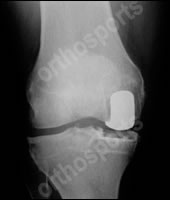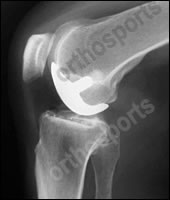Inside This section
Uni Knee Replacement
What Is This?
This operation is done for people who have arthritis in a specific part of their knee. It simply means that only a part of the knee joint is replaced through a smaller cut than would normally be used for a total knee replacement.
The knee is one joint but is made up of 3 sections or compartments. These are:
- the patellofemoral joint (knee cap part),
- medial compartment (inside) and
- lateral compartments (outside).
The medial and lateral compartments are between the femur and tibia (the thigh bone and the shin bone). Often only one of these compartments wears out – usually the medial one. If your pain is from one part of the knee only and x-ray confirms ‘disease’ in that part of the joint only then you may be suitable for this procedure. There are many reasons that you may not be suitable for this procedure.
What Are The Alternatives?
- As with all forms of arthritis all treatments short of surgery should be tried first: Examples of this are weight loss, pain killers, modifying your activities to avoid those that cause pain in the knee, anti-inflammatory tablets and so on.
- Osteotomy (cutting the bone and realigning it) so that when you walk the forces are shifted away from the arthritic part of the joint to the good part of the knee.
- Total knee replacement, which means replacing the whole knee.
What Is Actually Done?
A cut approximately 8cm long is made on the front of the knee to open the joint. The arthritic lining of the knee is removed and is replaced with a metal component ‘cemented’ to the femur and the tibia. A special plastic insert is placed between these metal pieces to produce an artificial joint. This procedure has been done with success for many years through a much larger incision with much more trauma to the knee. More recently it has become possible to do it through a much smaller incision, allowing the knee to recover faster.


X-Rays – Unicompartmental Knee Replacement
What are the advantages and disadvantages compared to a Total Knee Replacement?
Advantages Of Unicompartmental Surgery
- smaller operation
- smaller incision
- not as much bone removed
- shorter hospital stay
- shorter recovery period
- blood transfusion rarely required
- better movement in the knee
- feels more like a normal knee
- if still have pain can be converted to a total knee replacement
- able to be more active than after a total knee replacement
Disadvantages of Unicompartmental Surgery
- not quite as reliable as a total knee replacement in taking away all pain
- may not last as long as a total knee replacement.
- Very selective group of patients – can’t be done on everyone
Who Is Suitable?
- deally should be over 50 years of age
- one compartment involved clinically and on x-ray
- Pain interfering with day to day life
Who Is Not Suitable?
- patients with arthritis affecting more than one compartment
- patients with severe angular deformity
- patients with inflammatory arthritis eg. rheumatoid arthritis
- patients with a torn anterior cruciate ligament
- patients who have had a previous osteotomy
- patients who are involved in heavy work or contact sports
Summary
This is an excellent operation in the right patient. The biggest advantage is that it feels more like a normal knee and is quicker to recovery from. Its biggest disadvantage is that it is not quite as reliable as a total knee replacement.
If, for some reason, it does not relieve your pain then it can be converted to a total knee replacement
